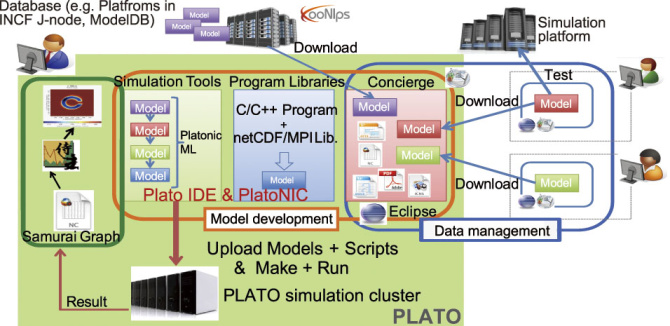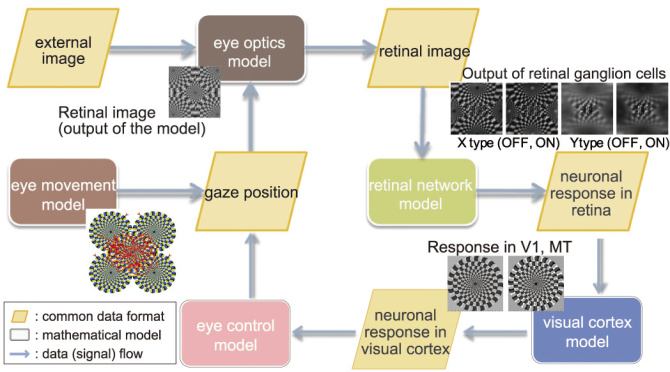
Brain and Neural WG
PLATO: Platform for a collaborative
brain system modeling toward
development of large scale
mathematical model.
1) Computational Science Research Program, RIKEN
2) Brain Science Institute, RIKEN
Keiichiro Inagaki 1) Takayuki Kannon 2) Nilton L. Kamiji 2) Koji Makimura 2)
Shiro Usui 1) 2)

The elucidation of information processing fulfilled by the
brain is regarded as the most difficult problem in natural
science. In the brain, about 100 billion nerve cells form a
network consisting of about 1 trillion contacts known as
synapses. It is thought that various information obtained
from the external world, such as vision and audition, is
processed flexibly and appropriately by this network in
the brain. The function of such complicated information
processing in the brain is being revealed mainly by
electrophysiological experiments. Together with the
recent dramatic progress made in computational
science, research to elucidate brain functions from the
perspective of computational science has also been
conducted by structuring part of the brain in detail as
a mathematical model, and carrying out simulations.
However, it is still difficult to describe the whole brain as
a large-scale mathematical model for simulation.
Since a vast amount of knowledge and sophisticated
techniques are required to construct a large-scale
brain model, it is difficult for a researcher to achieve
this by working alone. Therefore, it is considered
rather impor tant to collec t and accumulate the
knowledge obtained by the collaborative work of
various researchers, and to integrate it as a large-scale
model running on a computer. We are now designing a
method to integrate the knowledge and mathematical
models concerning various sites of the brain
obtained from conventional physiological and
computational research as a novel approach for
constructing a large-scale brain model. In our
approach, we are constructing an integrated
development environment consisting of
tools for collecting and managing the data
required for development and simulation of
models registered in the database server such
as ModelDB at Yale University and various
platforms of Neuroinformatics Japan-Node,
simulators, simulation server, and a result
visualization tool (Figure 1). In order to facilitate
interconnection of multiple models, we are
studying and developing a data format to
standardize the input and output of the model
for data exchange, and its supporting library.
The common format, for example, would
make it possible to connect mathematical
models produced with different programming
languages and/or simulator s, such as C
language and Python. Since the model input
and output are standardized, we can modify
and update a model into a large-scale model
and install a new mathematical model in a
plug-in manner. Interconnected models are
simulated in parallel by a system called Agent.
During the simulation, data communication
between models is also adjusted automatically
by accounting the progress of each model. By
providing a unified library for such a common
format and Agent, it is expected that the creator of the
model can develop a mathematical model that can bind
to other models without changing most of the program
codes.
For describing the information processing underlying
"vision", one of the brain functions, we are constructing
a large-scale model of the whole visual system by the
approach we have described. The human visual system
consists of eyes, optic system, retina and cerebral
cortex, where information from the external world are
processed at these multihierarchicall sites to achieve
functions such as recognition of objects and transition
of visual lines. By constructing mathematical models
for various sites in the brain, integrating them by the
method we described and doing simulations, we hope
to visualize the information processing that occurs when
humans look at an object, for example visual illusion
such as in Figure 2. In the future, by describing all the
sites in the brain involved in “vision” in collaboration
w ith v ar ious res earch er s invo lve d in this f iel d,
integrating them by the approach that we proposed,
and performing computer simulation as a large-scale
model of "vision" using K computer, it will become
possible to elucidate the visual information processing
that occurs in the brain.

Figure 1 : PLATO system environment
PLATO consists of 4 environments including a data management tool (http://
concierge.sourceforge.jp/), model development environment, simulation server
and the result drawing tool.

Figure 2. Configuration diagram of
a large-scale visual system model
S c h e m a t i c d i a g r a m o f a n
integrated mathematical model
of the visual system comprising
of the eye movement, the optic
system, the retina and the cortex,
a n d s a m p l e i m a g e o f e a c h
model output at simulation. The
mathematical model at each site is
described as an individual model,
and each model is connected by
the common format (Common
data format).
BioSupercomputing Newsletter Vol.4
- SPECIAL INTERVIEW
- In order to change from observation-type medical practice focusing on experience to prediction-type medical practice to construct the base of theoretical medicine
Professor, Department of Internal Medicine (Cardiovascular Medicine), Director of the Metabolic Disease Research Center, Bio-Research Medical Center, Tokai University Graduate School of Medicine, and Director, Department of Metabolic System Medicine, Tokai University General Medical Laboratory Shinya Goto - It is expected that new possibilities in nutrition science and health control will be opened up
by simulation science
EXECUTIVE PROFESSIONAL Health infomatics DEPT., Ajinomoto Co., Inc. Toshihiko Ando
- Report on Research
- The functions of a multidrug discharging transporter were verified by coarse graining molecular simulation (Molecular Scale WG)
Graduate School of Science, Kyoto University Shoji Takada / Xin-Qiu Yao / Hiroo Kenzaki - Cell simulation considering time-space (Cell Scale WG)
Computational Science Research Program, RIKEN Yasuhiro Sunaga - Development of HIFU simulator for non-invasive treatment with high-intensity focused ultrasound (Organ and Body Scale WG)
VCAD System Research Program, RIKEN Kohei Okita - PLATO: Platform for a collaborative brain system modeling toward development of large scale mathematical model.(Brain and Neural WG)
①Computational Science Research Program, RIKEN
②Brain Science Institute, RIKEN
Keiichiro Inagaki①/ Takayuki Kannon②/ Nilton L. Kamiji②/ Koji Makimura②/ Shiro Usui ①②
- Report
- Report on the workshop in BMB2011 (Joint Meeting of the 33rd Congress of the Molecular Biology Society of Japan and the 83th Congress of the Japanese Biochemical Society)
- Winter School 2011 for the Integrated Simulation of Living Matter
Computational Science Research Program, RIKEN Yasuhiro Ishimine (Organ and Body Scale WG)
The Institute of Medical Science, The University of Tokyo Hidetoshi Urakubo (Brain and Neural WG)
Computational Science Research Program, RIKEN Yasuhiro Sunaga (Cell Scale WG)
Computational Science Research Program, RIKEN Gen Masumoto (High-Performance Computing Team)
Computational Science Research Program, RIKEN Keiji Misawa (Data Analysis Fusion WG)
Computational Science Research Program, RIKEN Hisayuki Miyashita (Molecular Scale WG) - Winter School 2011 for the Integrated Simulation of Living Matter
